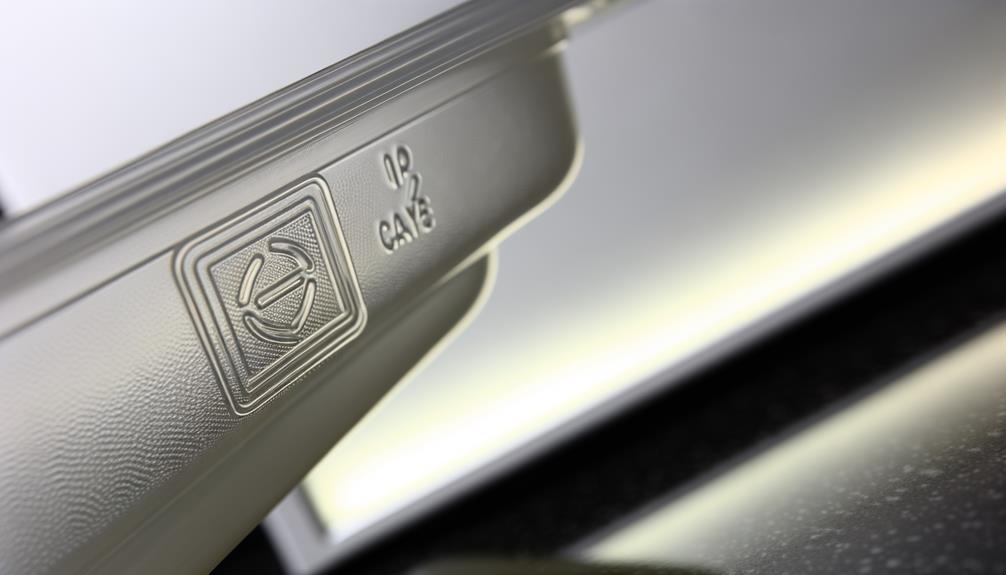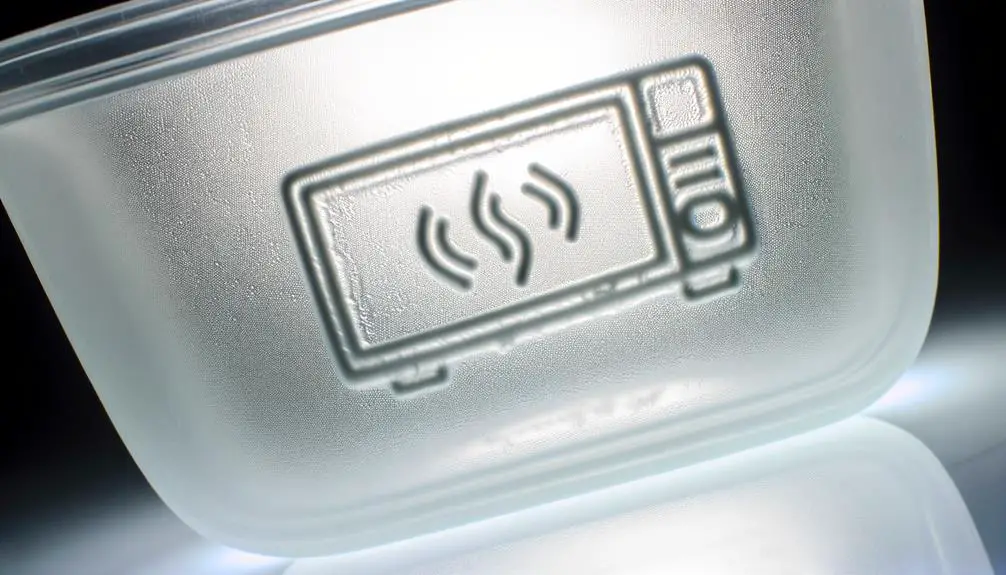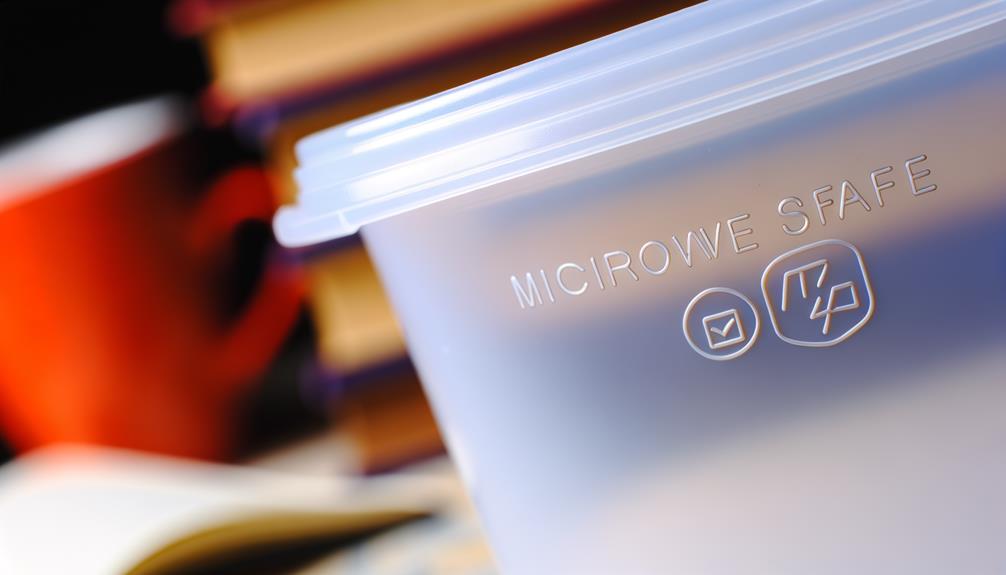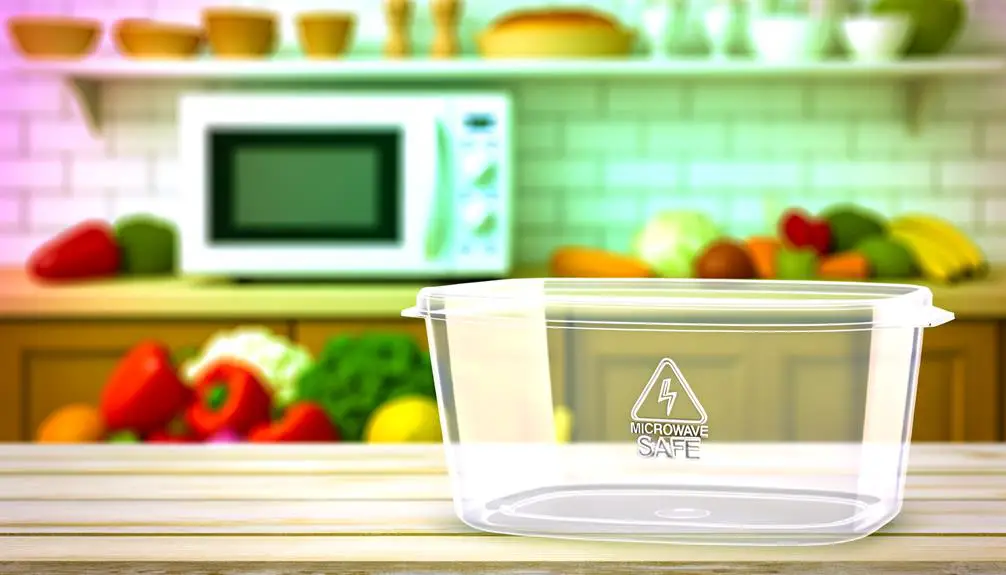How to Identify the Microwave Safe Symbol on Plastic Containers
Identifying the microwave safe symbol on plastic containers is vital to avoid chemical leaching during food heating. The symbol typically features wavy lines and is often placed at the bottom or side of the container.
Check for accompanying text, such as 'microwave safe,' which guarantees compliance with safety standards. Common safe plastics include PP (resin code 5) and PET (resin code 1).
Using these specific materials prevents heat deformation and guarantees food safety. Understanding these symbols and materials is important for informed, safe microwave usage.
For more detailed guidelines on using plastics safely in microwaves, continue here.

Key Takeaways
- The microwave safe symbol is typically depicted by wavy lines or a microwave icon.
- This symbol is usually found on the bottom or side of plastic containers.
- Plastics labeled with 'microwave safe' text ensure compliance and safe usage in microwaves.
- Common microwave safe plastics include PP (code 5) and PET (code 1).
- Using microwave safe plastics prevents the leaching of harmful chemicals during food heating.
Understanding Microwave Safe Symbols

Understanding the various microwave safe symbols on plastic products is fundamental for ensuring both the safety and efficacy of microwave usage. These symbols typically appear as icons or notations on the product's surface, indicating its suitability for microwave exposure. Common symbols include wavy lines, often three, which suggest microwave safety.
Additionally, the term 'microwave safe' explicitly denotes compliance. Such markings are pivotal in preventing the leaching of harmful chemicals or structural degradation of the plastic. It is imperative to recognize these symbols to avoid potential health hazards and maintain the integrity of the plastic.
Users should always refer to these indicators before microwaving plastic containers to guarantee safe food heating practices.
Types of Microwave Safe Plastics
When discussing types of microwave-safe plastics, it is important to focus on commonly used materials such as polypropylene (PP), high-density polyethylene (HDPE), and certain grades of polyethylene terephthalate (PET).
Identifying safe plastics involves examining the resin identification code and verifying the presence of the microwave-safe symbol.
Understanding these indicators guarantees the selection of appropriate materials that resist heat deformation and prevent chemical leaching during microwave use.
Common Plastic Types
Identifying the types of microwave-safe plastics is essential for ensuring safety and maintaining the integrity of both the food and the container. Various plastics are engineered to withstand microwave radiation without degrading or leaching harmful substances. Here are some common types of microwave-safe plastics:
| Plastic Type | Common Uses |
|---|---|
| Polypropylene (PP) | Food containers, yogurt cups |
| High-Density Polyethylene (HDPE) | Milk jugs, detergent bottles |
| Polyethylene Terephthalate (PET) | Beverage bottles, microwavable trays |
| Polycarbonate (PC) | Baby bottles, reusable bottles |
| Polystyrene (PS) | Disposable cutlery, foam containers |
Each of these plastics has unique properties that make them suitable for specific applications, especially in microwave settings. Understanding these types aids in choosing the right material for safe food preparation and storage.
Identifying Safe Plastics
To guarantee microwave safety, it is crucial to recognize specific symbols and labels that indicate a plastic container's suitability for microwave use. Identifying the correct symbols secures that the plastic will not degrade or release harmful chemicals when heated.
Commonly accepted microwave-safe plastics include:
- Polypropylene (PP) – Often marked with a recycling code '5', this plastic is known for its high melting point and durability.
- Polyethylene Terephthalate (PET or PETE) – Identified by the recycling code '1', this material is generally safe for short microwave use.
- Polycarbonate (PC) – Denoted by the recycling code '7', this plastic is robust and heat-resistant, although some concerns about bisphenol A (BPA) exist.
Understanding these codes ensures the safe use of plastics in microwave applications.
How to Identify the Symbol

The microwave-safe symbol on plastic is typically represented by a depiction of a microwave or wavy lines indicating heat. This symbol is vital for ensuring that plastic containers can withstand the microwave's heat without deforming or releasing harmful chemicals.
To accurately identify the symbol, one should inspect the bottom or side of the plastic container. Look for either a small image of a microwave or a set of wavy lines, often accompanied by the text 'microwave safe.' Additionally, some plastics may include a number within a triangle, but this alone does not indicate microwave safety.
It is important to cross-reference both the symbol and any accompanying text to confirm the plastic's suitability for microwave use.
Risks of Non-Microwave Safe Plastics
Using non-microwave safe plastics can lead to the leaching of harmful chemicals such as BPA and phthalates into food.
This contamination poses significant health risks, including endocrine disruption and increased cancer susceptibility.
Understanding these hazards is vital for ensuring safe food consumption and mitigating potential long-term health effects.
Harmful Chemical Leaching
Heating non-microwave safe plastics can lead to the leaching of harmful chemicals such as BPA and phthalates into food and beverages, posing significant health risks. These chemicals are known to disrupt endocrine functions and may contribute to various health issues.
Specifically, exposure to these substances has been linked to:
- Hormonal Imbalances: BPA and phthalates can mimic or interfere with the body's natural hormones, potentially leading to reproductive issues and developmental problems.
- Increased Cancer Risk: Long-term exposure to these chemicals has been associated with an elevated risk of certain cancers, including breast and prostate cancer.
- Metabolic Disorders: There is evidence to suggest that these substances may contribute to obesity and diabetes by disrupting metabolic processes.
Understanding these risks is essential for making informed decisions about plastic use.
Food Contamination Risks
Microwaving non-microwave safe plastics can cause the release of harmful substances into food, leading to potential contamination risks. This phenomenon occurs due to the breakdown of plastic polymers under high temperatures, which can result in the leaching of chemicals such as phthalates, bisphenol A (BPA), and other additives.
These chemicals can migrate into food items, particularly those with high fat or acid content, which are more susceptible to absorbing contaminants. Such migration not only degrades the quality and safety of food but also poses a significant threat to consumer health.
Understanding the material composition and thermal stability of plastic containers is essential for mitigating contamination risks and ensuring safe food consumption practices.
Health Hazards Explained
The health hazards associated with non-microwave safe plastics primarily stem from the release of toxic chemicals such as phthalates and bisphenol A (BPA) when exposed to microwave radiation. These compounds can migrate into food, posing significant risks to human health. Specifically, exposure to these chemicals has been linked to:
- Endocrine Disruption: Phthalates and BPA can interfere with hormone functions, potentially leading to reproductive and developmental issues.
- Carcinogenic Effects: Prolonged exposure to these substances has been associated with an increased risk of certain cancers.
- Neurological Impacts: Studies suggest that BPA exposure may affect brain development and function, leading to cognitive impairments.
Understanding these risks underscores the necessity of using microwave-safe plastics to safeguard health.
Benefits of Using Safe Plastics

Using microwave-safe plastics ensures that harmful chemicals do not leach into food during the heating process. This guarantees that food retains its nutritional integrity and eliminates the risk of ingesting toxic substances such as BPA, phthalates, or dioxins.
Additionally, safe plastics are engineered to withstand high temperatures without degrading, which enhances their durability and longevity. This translates to cost savings and environmental benefits, as these containers can be reused multiple times.
Moreover, microwave-safe plastics contribute to a safer culinary environment, reducing potential hazards associated with melting or warping.
Additional Safety Tips
When using microwave-safe plastics, it is important to follow specific guidelines to guarantee peak safety and performance. Adhering to these practices safeguards the integrity of the plastic and minimizes health risks.
- Avoid High-Fat Foods: High-fat foods can reach temperatures higher than the plastic's tolerance, risking chemical leaching. Use glass or ceramic for such items.
- Check for Damage: Inspect containers for cracks or warping before use. Damaged plastics may not perform as intended and could release harmful substances.
- Use Appropriate Lids: Ensure lids are also microwave-safe and left slightly ajar to allow steam to escape. This prevents pressure buildup, which could cause spills or container damage.
Conclusion
Coincidentally, the presence of microwave-friendly symbols on plastics aligns with the growing concerns about health and safety in modern society.
Identifying these symbols is essential to mitigating the risks associated with non-microwave friendly plastics.
The benefits of using microwave-friendly plastics, including the preservation of food integrity and prevention of harmful chemical leaching, are significant.
As such, understanding and adhering to these guidelines guarantees safe and efficient use of microwave technology in daily life.






